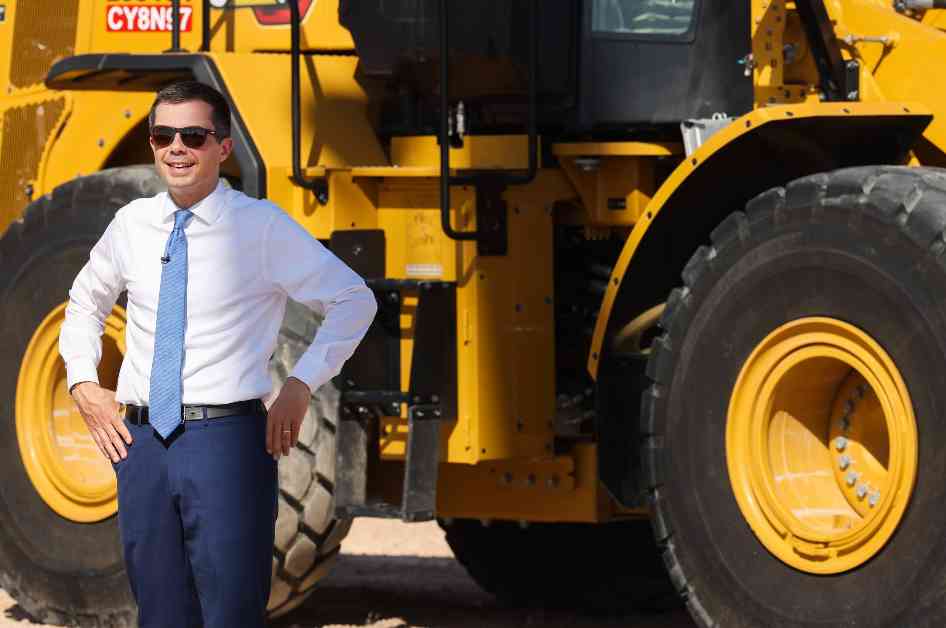U.S. Secretary of Transportation Pete Buttigieg made a significant visit to Las Vegas, Nevada, to kick off a groundbreaking ceremony for a new $378 million transit project. This project, which is the largest singular transit investment ever received by the Regional Transportation Commission of Southern Nevada (RTC), is part of the massive funding allocated to the Silver State through the Bipartisan Infrastructure Law.
The Maryland Parkway Overhaul
The U.S. Department of Transportation awarded the RTC a substantial $149 million grant to improve public transit access along a 12.5 mile stretch of Maryland Parkway from the South Transit Terminal to the Medical District. This area is home to approximately 63,000 residents, making it a crucial transportation corridor for the community.
The funding from the Bipartisan Infrastructure Law will bring about transformative changes to the Maryland Parkway bus line. Plans include reducing the number of lanes from three to two, creating dedicated shared bus-bike lanes, constructing 42 transit shelters, widening sidewalks, and enhancing lighting along the route. Additionally, the expanded bus service will operate 24/7 and feature 15 hydrogen fuel cell electric buses funded through another federal grant.
Secretary Buttigieg emphasized the positive impact of these improvements, stating, “We are saving people money. We are saving people time, and we are better connecting this community.” The new rapid transit system is expected to benefit not only those who utilize it directly but also the broader community.
Infrastructure Investments in Nevada
Secretary Buttigieg’s visit to Nevada is part of a larger effort by the Biden administration and Nevada Democrats to highlight the approximately $4 billion in infrastructure improvements coming to the state following the passage of the infrastructure bill in 2021. This significant investment aims to address critical infrastructure needs and create economic opportunities for Nevadans.
In addition to the Maryland Parkway project in Las Vegas, Buttigieg also visited Reno to highlight the construction starting on replacing a nearly 100-year-old bridge on Arlington Avenue. Furthermore, he is scheduled to speak at the annual Lake Tahoe summit, underscoring the importance of infrastructure investments in both urban and rural areas of the state.
Impacts on Public Transit and Communities
The current bus route along Maryland Parkway supports 9,000 daily riders, making it the fourth-highest ridership in Southern Nevada. With the planned infrastructure improvements, the RTC estimates that ridership will increase to 13,300 daily passengers, and travel time for transit riders will be reduced by approximately 20 percent.
The Maryland Parkway Corridor is home to a significant population of residents who do not have access to a vehicle, making it a crucial “transit-dependent” area. The project’s completion by fall 2026 is expected to support approximately 95,000 jobs and will involve the participation of nine local minority-owned firms through the Disadvantaged Business Enterprise program.
Representative Steven Horsford highlighted the economic benefits of the project, noting that over $31 million in contracts will be awarded to these minority-owned firms. This investment will particularly benefit parts of Las Vegas where the poverty rate is as high as 35 percent, demonstrating a commitment to equitable economic development.
Environmental Considerations and Climate Impact
In addition to addressing transportation and economic needs, the Maryland Parkway project aims to tackle climate concerns by introducing a dedicated fleet of zero-emission vehicles. This initiative aligns with broader efforts to reduce carbon emissions and promote sustainability in the transportation sector.
Las Vegas, known as one of the nation’s fastest-warming cities, faces climate challenges such as extreme heat and rising temperatures. The project’s emphasis on zero-emission vehicles, expanded shade through new bus shelters and trees, and improvements in infrastructure design underscores a commitment to environmental stewardship and climate resilience.
Community Engagement and Future Developments
The decision to prioritize an expanded bus service over a proposed $1 billion light rail option demonstrates a strategic approach to meeting the region’s transit needs efficiently and effectively. By investing in public transit infrastructure, Nevada aims to enhance connectivity, reduce congestion, and improve the overall quality of life for residents.
State officials are optimistic that projects like Brightline’s high-speed rail connecting Las Vegas to Southern California will help alleviate traffic on Interstate 15, a critical transportation artery in the region. The completion of this high-speed rail project by 2028 is expected to have far-reaching impacts on regional mobility and economic development.
Democratic members of Nevada’s congressional delegation, including Senator Catherine Cortez Masto and Representatives Dina Titus, Susie Lee, and Steven Horsford, joined Secretary Buttigieg at the ceremony in Boulevard Mall. Their presence underscored the importance of continued investment in infrastructure to support vibrant and resilient communities across the state.
In conclusion, the Maryland Parkway transit project in Las Vegas represents a significant milestone in Nevada’s infrastructure development efforts. Through strategic investments, partnerships with local communities, and a commitment to sustainability, the project aims to enhance public transit access, create economic opportunities, and address environmental challenges. Secretary Buttigieg’s visit and the broader infrastructure investments in Nevada signal a promising future for transportation and infrastructure development in the Silver State.



